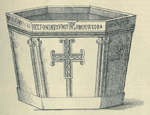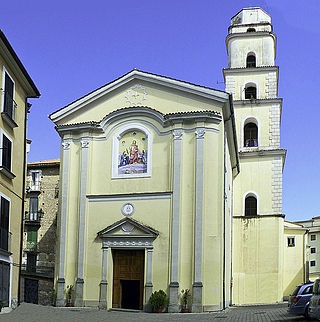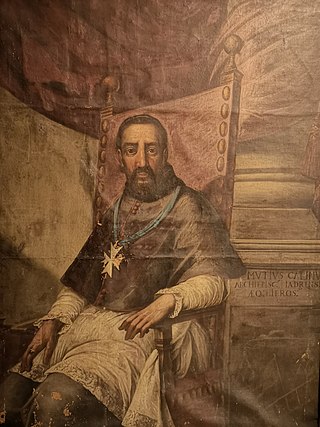| |
| Part of a series on the |
| Catholic Church in Croatia |
|---|
 |
This is a list of the bishops of Nin, named after the town of Nin, Croatia. The Bishopric was most likely founded in the middle of the 9th century. [1] [2] [3]
| |
| Part of a series on the |
| Catholic Church in Croatia |
|---|
 |
This is a list of the bishops of Nin, named after the town of Nin, Croatia. The Bishopric was most likely founded in the middle of the 9th century. [1] [2] [3]
| Bishop | Office | Notes |
|---|---|---|
| Theodosius | 879-886 [4] [5] | Listed by Daniele Farlati, Pius Basilius Gams, Carlo F. Bianchi, Ivan A. Gurato and the official Catholic schematisms. [5] |
| Alfredus | c. 890 [5] | |
Gregorius  | c. 900–929 | Gregory was the bishop of Nin and as such was under strong protection of King Tomislav. At the Synod in 925, held in Split, Gregory lost to the Archbishop of Split, he was offered the Sisak Bishopric, but he refused. After the conclusions of the first Synod Gregory complained again in 927/8 but was rejected and his Nin Bishopric was abolished, Gregory himself being sent off to the Skradin Bishopric, after which he disappears from the annals of history. [ citation needed ] |
| Abolished | ||
| Andreas | c. 1050–1072 | |
| Forminus | fl. 1075 | |
| Gregorius | fl. 1104 | |
| Rodanus | fl. 1163 | |
| Matthaeus | 1170–1194 | |
| Ioannes | c. 1206 | |
| B. | 1229 [5] [6] | |
| S.Janson | 1230, 1241 | |
| Ioannes | 1253, 1258 | |
| Stephanus | 1272 | |
| Marcellus | 1288 | |
| Marcus | 1291 [7] | |
| Ioannes | 1318? [7] | |
| Natalis | 1328 [7] | |
| Georgius | ? [7] | |
| ? | ||
| Juraj Divnić "Juraj the Dalmatian" | end of 15th century | He was one of the more important Catholic bishops of Croatian origin in his time. He was born in Šibenik, and was part of the known Divnić family, which settled in Šibenik in the 14th century from Skradin, and had likely settled there from Bosnia earlier. [8] Bishop Juraj wrote Pope Alexander VI about the catastrophe right after the Battle of Krbava. |
| Horatius Belloti Venetus O. M. Conv. | 1592–1602 [9] | |
| Blasius Mandevius | 1602–1645 [9] | |
| Simeon Diphnicus | 1646–1649 [9] | |
| Georgius Georgiceo | 1649–1653 [9] [10] | |
| Franciscus Andronicus | 1653–1666 [9] | |
| Franciscus Grassi | 1667–1677 [9] | |
| Ioannes Burgofortis (Giovanni Borgoforte) | 1677–1687 [9] | |
| Ioannes Vusius (Giovanni Vusich) | 1688–1689 [9] | |
| Georgius Parchich | 1690–1703 [9] | On 20 April 1693, he sent a report to the Congregation that there were 5486 Roman Catholics and 7363 Orthodox Serbs in his Bishopric. In the territory of his bishopric there was also a Serbian episcope. The Roman Catholics had 21 priests, while the Orthodox had 15. Bishop Georgius said that he worked to Uniate the Orthodox, preaching for them and teaching them the faith and the true, Catholic teachings. On 1 June 1696, he mentions that thanks to his efforts the population of the village of Poločnik denounced the "Schismatic wrongs" – the Orthodox faith, and accepted the Roman faith. [ citation needed ] |
| Martinus Dragolius (Dragolovich) | 1703–1708 [9] | |
| Ioannes Manola | 1709–1711 [9] | |
| Antonius Rosignoli | 1713–1715 [9] | |
| Nicolaus Drasich | 1716–1720 [9] | |
| Bernardus Dominicus Leoni | 1722–1727 [9] | |
| Ioannes Andreas Balbi | 1728–1732 [9] | |
| Hieronvmus Fonda | 1733–1738 [9] | |
| Ioannes Fridericus Orsini Rosa | 1738–1742 [9] | |
| Thomas Nechich | 1743–1754 [9] | |
| Antonius Tripcovich | 1754–1771 [9] | |

The Italian Catholic Diocese of Vallo della Lucania, in Campania, has existed under this name since 1945. It is a suffragan of the Archdiocese of Salerno-Campagna-Acerno.

The Italian Catholic Diocese of Livorno in Tuscany, was created in 1806. It is a suffragan of the Archdiocese of Pisa. The current bishop is Simone Giusti.
The Italian Catholic diocese of Fossombrone existed in the province of Pesaro and Urbino until 1986, when it was united into the diocese of Fano-Fossombrone-Cagli-Pergola. It was a suffragan of the archdiocese of Urbino.

The Diocese of Alife-Caiazzo is a Roman Catholic ecclesiastical territory in Campania, southern Italy, created in 1986. In that year the historic Diocese of Alife was united with the Diocese of Caiazzo. The diocese is a suffragan of the Archdiocese of Naples.
The Roman Catholic Diocese of Alessano was a Roman Catholic diocese in Italy, located in the city of Alessano, in the province of Lecce, part of Apulia region of south-east Italy. On 28 June 1818, it was suppressed to the Diocese of Ugento.
Ottaviano Garzadori was a Roman Catholic prelate who served as Archbishop of Zadar (1624–1639) and Bishop of Boiano (1622–1624).
The Diocese of Minori was a Roman Catholic diocese in Italy, located in Minori, province of Salerno, region of Campania in the ecclesiastical province of Amalfi. In 1815, it was suppressed, and its territory and Catholic population assigned to the Archdiocese of Amalfi.

Muzio Calini was a Roman Catholic prelate who served as Archbishop of Terni (1566–1570) and Archbishop of Zadar (1555–1566).
The Diocese of Ossero or Diocese of Osor was a Roman Catholic diocese located in the port town of Ossero on the island of Cres in Primorje-Gorski Kotar County in western Croatia. In 1828, it was suppressed along with the Diocese of Arbe to the Diocese of Krk. In 1933 it was restored as a Titular Episcopal See.
Gerolamo Ragazzoni or Gerolamo Regazzoni was an Italian renaissance humanist and Roman Catholic prelate who served as Bishop of Bergamo (1577–1592), Apostolic Nuncio to France (1583–1586), Bishop of Novara (1576–1577), Apostolic Administrator of Kisamos (1572–1576), Coadjutor Bishop of Famagusta (1561), and Titular Bishop of Nazianzus (1561).
Luis Morales, O.S.A. was a Roman Catholic prelate who served as Bishop of Tropea (1667–1681) and Bishop of Ariano (1659–1667).
Biagio Molino or Biaggio Molina or Biageo de Molina (1380–1447) was a Roman Catholic prelate who served as Titular Patriarch of Jerusalem (1434–1447), Patriarch of Grado (1427–1434), Archbishop of Zadar (1420–1427), and Bishop of Pula (1410–1420).
Lorenzo Zanni or Lorenzo Zane was a Catholic prelate who served as Bishop of Brescia (1478–1480), Titular Patriarch of Antioch (1473–1478), Bishop of Treviso (1473–1478), Titular Patriarch of Jerusalem (1458–1473), and Archbishop of Split (1452–1458).
Giorgio Giorgicci or Georgius Georgiceo was a Roman Catholic prelate who served as Bishop of Krk (1653–1660) and Bishop of Nona (1649–1653).
Georgius Parchich was a Roman Catholic prelate who served as Bishop of Nona (1690–1703).
Pietro Leoni was a Roman Catholic prelate who served as Bishop of Verona (1691–1697) and Bishop of Ceneda (1667–1691).
Bernardino Scala was a Roman Catholic prelate who served as Bishop of Montefeltro (1643–1667) and Bishop of Bisceglie (1637–1643).
Alvise Molino was a Roman Catholic prelate who served as Archbishop of Treviso (1595–1604) and Archbishop of Zadar (1592–1595).
Giovanni Borgoforte (1640–1687) was a Roman Catholic prelate who served as Bishop of Nona (1677–1687).
Giovanni Vusich (1647–1689) was a Roman Catholic prelate who served as Bishop of Nona (1688–1689).
Jedan od značajnih biskupa hrvatskoga roda iz toga doba bio je Juraj Divnić, Šibenčanin, iz poznate obitelji Divnića, koja se doselila u Šibenik u 14. stoljeću iz Skradina, a tamo još ranije, vjerojatno iz Bosne.3